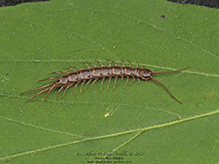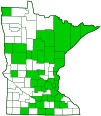brown centipede
(Lithobius forficatus)
Conservation • Description • Habitat • Biology • Distribution • Taxonomy
|
|
||||||||||||||
Description |
Brown centipede is an exotic, widespread, very common, typical stone centipede. It is native to Europe and has been introduced into North America and New Zealand. The time and place of its introduction into North America is unknown, but it is thought to have been during colonial times in the 15th century. It probably arrived in plants brought to or shipped to America by early European settlers. Since then, it has been reintroduced many times. It is now found throughout the United States and southern Canada. It is the most common centipede in the northern U.S. Though rarely found far from places of human activity, it is considered “exceedingly abundant” throughout its range. Brown centipede is a habitat generalist, but it is highly susceptible to desiccation, which restricts it to damp or moist places. It is found in forests, grasslands, and in places with scarce vegetation; on soil, bark, and fallen tree trunks; in leaf litter, moss, and crevices; under mulch, rocks, and stones; and in greenhouses, nurseries, and households. It feeds on small insects, spiders, earthworms, and other arthropods, including sowbugs and millipedes. Adults are rich chestnut brown, 11⁄16″to 1¼″ (18 to 32 mm) in length, and ⅛″ (2.8 to 4.0 mm) wide. The head is sometimes reddish. The antennae are relatively short, no more than one third the length of the body. They usually have 39 to 43 segments, but they may have as few as 30 or as many as 55. The last segment is twice as long as the preceding one. On each side of the head there is a tight group of 19 to 34 simple eyes (ocelli) in 5 or 6 rows. There is a pair of poison claws under the head. Recently hatched young have just seven pairs of legs. They gain a body segment and a pair of legs with each molt. The adult body has 18 segments, and it is not constricted behind the head. Fifteen of the segments have an upper skeletal plate (tergite) and a single pair of legs. Each tergite has a well-developed, flattened, plate-like extension (paranotum) on each side. The paranota are mostly, or at least in part, the same color as the legs. The tergites on segments 1, 3, 5, 7, 8, 10, 12, and 14 are much longer than those on the remaining segments. The tergites on segments 9, 11, and 13 have a large triangular projection at each rear corner. The plate on the underside of the first segment of the thorax (prosternum) has 5 teeth on each side. The legs are often pale. The rear legs extend backward and are long, resembling a second pair of antennae. |
Size |
Total length: 11⁄16″ to 1¼″ (18 to 32 mm) |
Similar Species |
Habitat |
Forests, grasslands, and urban areas |
Biology |
Season |
|
Behavior |
Like most centipedes, brown centipedes are fast runners. |
Life Cycle |
|
Food |
Small insects, spiders, earthworms, and other arthropods |
Distribution |
||
|
Sources |
|
| 1/18/2025 | ||
Occurrence |
||
Exceedingly abundant |
||
Taxonomy |
|
Subphylum |
Myriapoda (myriapods) |
Class |
Chilopoda (centipedes) |
Subclass |
Pleurostigmophora |
Order |
Lithobiomorpha (stone centipedes) |
Family |
Lithobiidae |
Genus |
Lithobius (typical stone centipedes) |
Subgenus |
Lithobius |
Subordinate Taxa |
|
brown centipede (Lithobius forficatus forficatus) brown centipede (Lithobius forficatus pulcher) |
|
Synonyms |
|
Lithobius ameles Lithobius americanus Lithobius argus Lithobius biunguiculatus Lithobius biunguis Lithobius biungulatus Lithobius bonensis Lithobius brevicalcaratus Lithobius brevicornis Lithobius britannicorum Lithobius cheruscus Lithobius convenicus Lithobius coriaceus Lithobius curtirostris Lithobius degener Lithobius diampolisi Lithobius forcipata Lithobius forficatus ssp. biunguis Lithobius forficatus ssp. biungulatus Lithobius forficatus ssp. brevicalcaratus Lithobius forficatus ssp. britannicorum Lithobius forficatus ssp. cheruscus Lithobius forficatus ssp. convenicus Lithobius forficatus ssp. degener Lithobius forficatus ssp. sorrentinus Lithobius forficatus ssp. villosus Lithobius golemanskyi Lithobius hardwickei Lithobius hortensis Lithobius interrupta Lithobius laevilabrum Lithobius leachii Lithobius muscorum Lithobius parisiensis Lithobius parvolus Lithobius pulcher Lithobius quadridentatus Lithobius rapitus Lithobius sorrentinus Lithobius trilineatus Lithobius vesuvianus Lithobius villosus Lithobius vulgaris Scolopendra forcipata Scolopendra forficata Stenomera interrupta |
|
Common Names |
|
brown centipede common centipede garden centipede stone centipede |
|
Glossary
Ocellus
Simple eye; an eye with a single lens. Plural: ocelli.
Tergite
The upper (dorsal), hardened plate on a segment of the thorax or abdomen of an arthropod or myriapod.
Visitor Photos |
||
Share your photo of this myriapod. |
||
This button not working for you? |
||
Alfredo Colon |
 |
MinnesotaSeasons.com Photos |
||
|
||
|
||

Visitor Videos |
||
Share your video of this myriapod. |
||
This button not working for you? |
||
|
Other Videos |
||
Centipede hunting small spiders |
About
Feb 29, 2016 Lithobius forficatus |
Mandibulata Centipede Lithobius Forficatus Macro 4K |
About
Aug 18, 2019 Mandibulata Centipede Lithobius Forficatus Macro 4K |
Lithobius forficatus |
About
Mar 16, 2021 Stone centipede (Lithobius forficatus) |
Stone centipede (Lithobius forficatus) |
About
Jun 17, 2013 |

|
Created: 1/18/2025 Last Updated: © MinnesotaSeasons.com. All rights reserved. |




